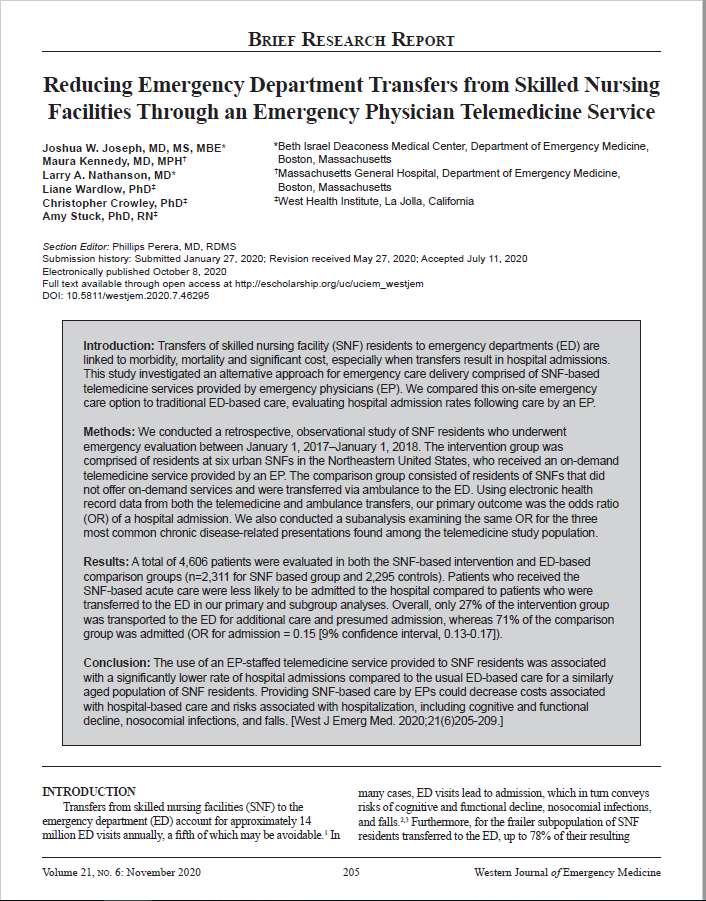UC Irvine
Western Journal of Emergency Medicine: Integrating Emergency Care with Population Health
Volume 21, No. 6: November 2020
Authors: Joshua W. Joseph, MD, MS, MBE*, Maura Kennedy, MD, MPH†, Larry A. Nathanson, MD*, Liane Wardlow, PhD‡, Christopher Crowley, PhD‡, and Amy Stuck, PhD, RN‡
Introduction: Transfers of skilled nursing facility (SNF) residents to emergency departments (ED) are linked to morbidity, mortality and significant cost, especially when transfers result in hospital admissions. This study investigated an alternative approach for emergency care delivery comprised of SNF-based telemedicine services provided by emergency physicians (EP). We compared this on-site emergency care option to traditional ED-based care, evaluating hospital admission rates following care by an EP.
Methods: We conducted a retrospective, observational study of SNF residents who underwent emergency evaluation between January 1, 2017–January 1, 2018. The intervention group was
comprised of residents at six urban SNFs in the Northeastern United States, who received an on-demand telemedicine service provided by an EP. The comparison group consisted of residents of SNFs that did not offer on-demand services and were transferred via ambulance to the ED. Using electronic health record data from both the telemedicine and ambulance transfers, our primary outcome was the odds ratio (OR) of a hospital admission. We also conducted a subanalysis examining the same OR for the three most common chronic disease-related presentations found among the telemedicine study population.
Results: A total of 4,606 patients were evaluated in both the SNF-based intervention and ED-based comparison groups (n=2,311 for SNF based group and 2,295 controls). Patients who received the SNF-based acute care were less likely to be admitted to the hospital compared to patients who were transferred to the ED in our primary and subgroup analyses. Overall, only 27% of the intervention group was transported to the ED for additional care and presumed admission, whereas 71% of the comparison group was admitted (OR for admission = 0.15 [9% confidence interval, 0.13-0.17]).
Conclusion: The use of an EP-staffed telemedicine service provided to SNF residents was associated with a significantly lower rate of hospital admissions compared to the usual ED-based care for a similarly aged population of SNF residents. Providing SNF-based care by EPs could decrease costs associated with hospital-based care and risks associated with hospitalization, including cognitive and functional decline, nosocomial infections, and falls. [West J Emerg Med. 2020;21(6)205-209.]
*Beth Israel Deaconess Medical Center, Department of Emergency Medicine, Boston, Massachusetts
†Massachusetts General Hospital, Department of Emergency Medicine, Boston, Massachusetts
‡West Health Institute, La Jolla, California
Read the full paper on eScholarship or download below.

